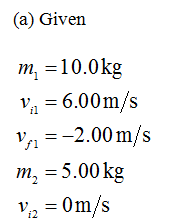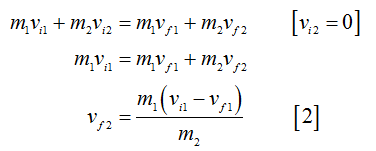When there is motion is both directions, state which direction is positive at the START of the problem. For the impulse-momentum and the conservation of momentum problems: Plug your GIVEN VALUES into the equation FIRST then do the algebra. Use the following equations: F t = m vf -m vi m1 vi1 + m2 vi2 = m1 vf1 + m2 vf2 m1 vi1 + m2 vi2 = (m1 + m2) vf (m1 + m2) Vi = m1 vf1 + m2 vf2 5. ) A mass of 10.00 kg is rolling across a frictionless surface at 6.00 m/s to the right. The first mass strikes a 5.00 kg mass that is initally at rest. After the collision the larger mass object is traveling at 2.00 m/s to the left. a. ) what is the velocity and dirction of travel for the lighter mass object? Show conversions step by step, if any.
When there is motion is both directions, state which direction is positive at the START of the problem.
For the impulse-momentum and the conservation of momentum problems: Plug your GIVEN VALUES into the equation FIRST then do the algebra. Use the following equations:
F t = m vf -m vi
m1 vi1 + m2 vi2 = m1 vf1 + m2 vf2
m1 vi1 + m2 vi2 = (m1 + m2) vf
(m1 + m2) Vi = m1 vf1 + m2 vf2
5. ) A mass of 10.00 kg is rolling across a frictionless surface at 6.00 m/s to the right. The first mass strikes a 5.00 kg mass that is initally at rest. After the collision the larger mass object is traveling at 2.00 m/s to the left.
a. ) what is the velocity and dirction of travel for the lighter mass object?
Show conversions step by step, if any.
(5) The motion in right direction is taken as positive and to the left is taken as negative.

Use the equation

Solve for the velocity of the lighter mass by using equation (1) is

Trending now
This is a popular solution!
Step by step
Solved in 3 steps with 4 images









